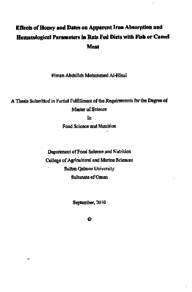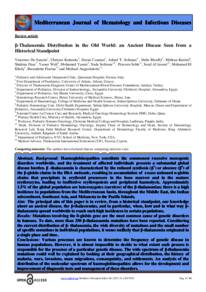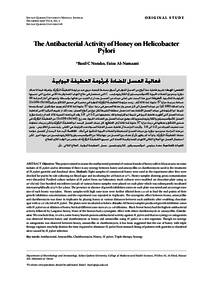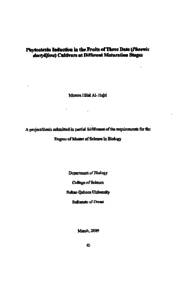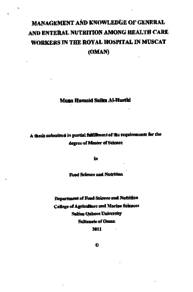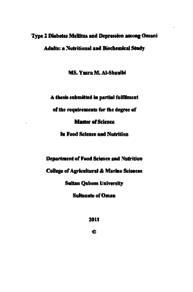Document
Effects of honey and dates on apparent iron absorption and hematological parameters in rats fed diets with fish or camel meat
Publisher
Sultan Qaboos University
Gregorian
2010
Language
English
English abstract
Iron deficiency anemia (IDA) is one of the most common diseases in the world and is the most prevalent in the Sultanate of Oman. It is associated with alternations in many metabolic processes in the body. The manifestations of these alterations have been noted in immune function, cognitive performance, energy metabolism and exercise or work performance.
This study aims to provide scientific information that would help reduce the incidence of iron deficiency anemia or enhance apparent iron absorption, using Wister rat, as an experimental model. Many studies have been conducted on the effects of various types of foods and beverages intake on iron bioavailability, but to the best of our knowledge, the present study is the first to investigate the effects of honey and dates on apparent iron absorption in diets containing camel or fish meat. This study was intended to fill the gap in the literature by investigating the effects of consuming honey and dates on the total iron, heme and non-heme iron in different types of meat by using rats as a model.
Total iron, heme and non-heme in camel, cattle, goat, chicken, and fish meat samples were determined. Two feeding experimental studies were carried out. The first experiment concentrated on the study of the effect of iron diets on rat performance. The second study was carried out to determine the effect of honey and dates on apparent iron absorption in rats. Fresh meat samples of cattle, sheep, goats, camel, chicken, and fish were cooked at 70°C and 100°C for 60 or 90 minutes, and total iron, heme and non-heme iron content were determined in fresh and cooked samples. The test diets included iron deficient diet (IDD), IDD plus synthetic iron, IDD plus camel meat, and IDD plus fish, with drinking water, diluted honey or diluted date syrup. Rat performance and total iron, heme and non-heme iron digestibility coefficients were determined in 12 experimental diets using Wister male rats at 120 and 180 days of age as models. Body weight, feed intake and feed conversion ratio were recorded weekly up to 180 days. At the end of the experiment, rats were sacrificed and blood samples were collected to estimate total iron, heme and non-heme iron concentration levels Samples from fish and camel meat had significantly (P<0.05) higher heme iron content than those of cattle, goat and chicken. Goat meat samples had significantly (P<0.05) higher total iron than those of chicken. Significant (P<0.05) loss of total iron and heme iron during cooking increased with increasing temperature and duration. Cooking meat at 100°C for 90 min exerted the highest effect mainly on heme iron in cattle, camel and fish meat samples. The highest digestibility coefficient at 120 day of age was recorded for the diets composed of fish plus honey and dates, and at 180 days of age, the diet comprised of fish plus distilled water showed the highest values. However, the digestibility coefficient of total iron did differ significantly among all experimental diets at 120 and 180 days of age. There was no significant treatment effect on performance of rats fed different experimental diets, and there were no major effects of experimental diet on the relative weight of rats' organs. Rats fed a diet deficient in iron showed higher RBC counts compared to rats fed other diets. Fish and camel meats are rich sources of total and heme iron than other meat sources, and thus, might be considered as potential sources of dietary iron for human consumption. Moderate temperature should be used in cooking meats to conserve total and heme iron. Consumption of honey and dates could enhance iron absorption which may lead to reduced levels of IDA in a country recording high prevalence IDA such as Oman.
Member of
Resource URL
Arabic abstract
يعتبر فقر الدم الناتج عن نقص الحديد من أكثر الأمراض شيوعا في العالم وانتشارا في سلطنة عمان. يرتبط هذا النقص بالعمليات الأيضية في الجسم مما يؤثر على مناعة الجسم و الأداء المعرفي و التمثيل الغذائي والطاقة وممارسة العمل و الأداء اليومي. تم إجراء العديد من الدراسات عن آثار تناول العديد من الأطعمة و المشروبات على توفر الحديد إلا أنه حسب علمنا فان هذه الدراسة تعتبر الأولى من نوعها التي تتطرق إلى تأثير تناول العسل و التمور على امتصاص الحديد في الجسم أثناء تناول انواع مختلفة من اللحوم (لحم الإبل والضأن والماعز والأسماك و الدجاج)، تم اخذ عينات من هذه اللحوم وطهيها في درجة حرارة ۷۰ و ۱۰۰ مئوية لمدة ۹۰ و ۹۰ دقيقة لمعرفة تأثير درجات الحرارة وطول فترة الطبخ على توفر الحديد. أظهرت النتائج بأن لدرجة الحرارة والفترة الزمنية تأثير معنوي ( 0 . 05>P) على فقدان مجموع الحديد وحديد الهيم ( heme iron) والحديد الغيرهیمی ( non - heme iron). لقد أدى طهي اللحوم على ۱۰۰ درجة مئوية لمدة 90 دقيقة إلى نقصان معنوي ( 0 . 05>P) في حديد الهيم والحديد الغير هيمي في لحوم الأبقار والإبل والأسماك. أما في عينات لحوم الماعز فقد كان التأثير معنويا ( 0 . 05>P) حيث تدني مجموع الحديد بنسبة 46 . 5 % عن ما هو في الدجاج. أما في عينات لحوم الأسماك و الإبل كان محتوى الحديد الكلى وحديد الهيم والحديد الغيرهیمی هو الأعلى معنويا ( 0 . 05>P) عن لحوم الأبقار والماعز والدجاج، ولقد سجل أعلى معامل الهضم خلال عمري ۱۲۰ و ۱۸۰ يوما في الوجبات المؤلفة من الأسماك بالإضافة إلى العسل والتمر. تميز الغذاء المكون من الأسماك بالإضافة إلى الماء بتلك الخاصية. تم تحديد محتويات الحديد وحديد الهيم والحديد الغير هيمي بقياس درجة هضم الحديد في اثني عشر معاملة غذائية باستخدام فئران من نوع Wister عند عمري ۱۲۰ و ۱۸۰ يوما. وأشارت نتائج هذه الدراسة إلى عدم وجود تأثير للمعاملات الغذائية على معدل النمو، واستهلاك العلف ونسبة التحويل الغذائي واوزان الأعضاء الداخلية في الفئران. في نهاية التجربة جمعت عينات من الدم لمعرفة التركيب الكيميائي والحيوي للدم واظهرت النتائج ارتفاع كريات الدم الحمراء الفئران التي تناولت غذاء ينقصه الحديد مقارنة بالفتران التي تغذت الوجبات الأخرى. اعطت نتائج هذه الدراسة فهما أفضل لتأثير العادات الغذائية المحلية وخاصة استهلاك العسل و التمور مع وجبات الطعام. ينصح باستخدام الحرارة المعتدلة في طهي اللحوم المحافظة على كميات الحديد. أشارت النتائج إلى آن لحوم الإبل والأسماك هي من المصادر الغنية بالحديد من بين اللحوم المستخدمة في هذه التجربة ويمكن اعتبارها مصادر مهمة للاستهلاك البشري كما أن استهلاك العسل و التمور يعزز توافر الحديد الحيوي في جسم الإنسان الأمر الذي قد يؤدي إلى خفض معدلات نقص الدم الناشئ من نقص الحديد في بلدان تتميز بانتشار أمراض فقر الدم مثل سلطنة عمان.
Category
Theses and Dissertations

